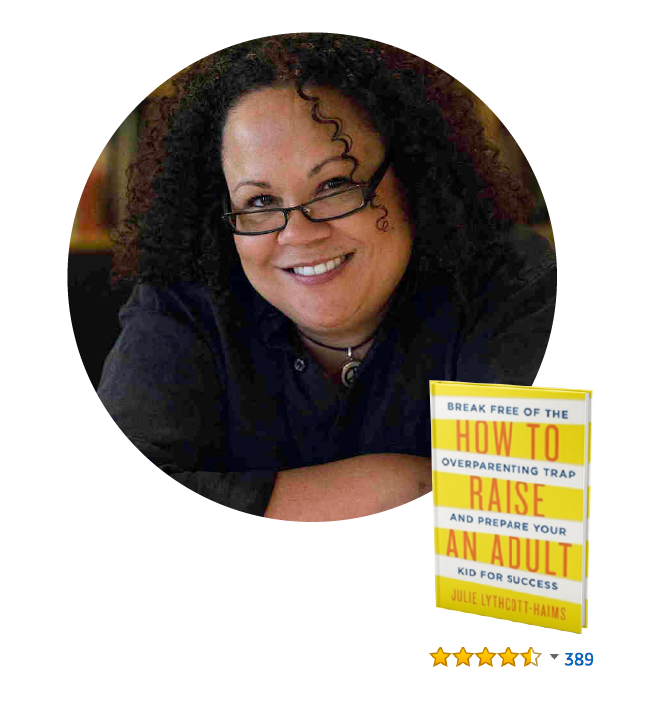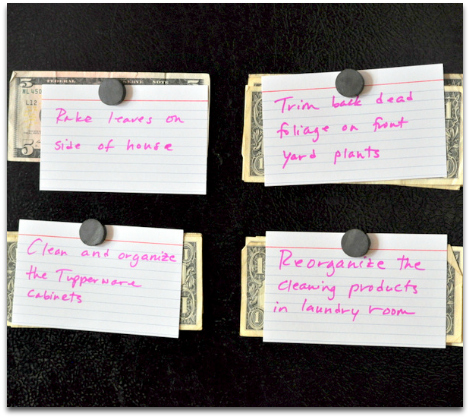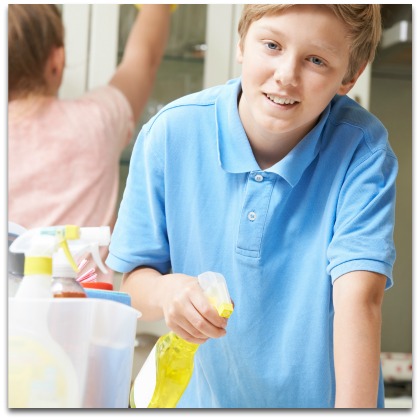 Three kids. Two cats. One dog. Zero time to fret about myself and my job, let alone the state of our home.
Three kids. Two cats. One dog. Zero time to fret about myself and my job, let alone the state of our home.
But fret, I must, if I want a calm, clutter-free home.
My husband and I have three daughters, evenly-aged at twelve, ten, and eight, and a few years ago we found a chore schedule that transformed our household chaos and empowered our kids to make valuable contributions to our home.
I believe that while parents should expect their kids to help around the house, the skills that children gain by performing regular housekeeping tasks are crucial for character development.
 Chores help kids become responsible adults. Julie Lythcott-Haims, a former Stanford University dean and author of the recent bestselling book titled How to Raise an Adult: Break Free of the Overparenting Trap and Prepare Your Kid for Success, says in her TED Talk that kids (and parents) should be less obsessed with things like school grades and test scores and more focused on things like love and chores.
Chores help kids become responsible adults. Julie Lythcott-Haims, a former Stanford University dean and author of the recent bestselling book titled How to Raise an Adult: Break Free of the Overparenting Trap and Prepare Your Kid for Success, says in her TED Talk that kids (and parents) should be less obsessed with things like school grades and test scores and more focused on things like love and chores.
“Did I just say chores?” Lythcott-Haims asks her TED audience, and indeed she did because the Harvard Grant Study, one of the longest longitudinal studies ever conducted, found that kids whose parents asked them to perform household duties were more likely to find professional success later in life.
And the earlier they start, the better, Lythcott-Haims argues. Kids need to feel like they are an integral part of the home. Giving them regular, age-appropriate tasks will instill in children a sense of community and shared purpose, a deeper understanding of responsibility, and the “grit” to accomplish a task that might seem daunting.
 Curious to know more about how chores can really help our children develop grit and perseverance? We partnered with Julie Lythcott-Haims, Dean of Freshman and Undergraduate Advising at Stanford University, mom and best-selling author, to create the Fostering Independence Masterclass for you.
Curious to know more about how chores can really help our children develop grit and perseverance? We partnered with Julie Lythcott-Haims, Dean of Freshman and Undergraduate Advising at Stanford University, mom and best-selling author, to create the Fostering Independence Masterclass for you.
This packed masterclass is one of the 100+ masterclasses you get when you join the AFineParent Academy. Click here to learn more.
Our family had switched chore strategies faster than our clothes, mostly because one approach was fine for our older daughters but too complicated for our youngest, or another method was too “childish” for our big kids but just right for the littlest.
Before our family found this successful strategy, we had tried magnets-and-fridge chore charts, stickers-and-happy-faces on paper, and plain, old shouting out to anyone within earshot, “Can someone take out the stinky trash, please?!”
Sometimes, our charts were so complicated that even my husband and I couldn’t make heads or tails out of which kid had performed what job. It became so frustrating that I often resorted to doing every chore myself, and most parents know that when one family member is trying to hold everything together, things fall apart.
Our system works for us, and it works for now. There most certainly will come a day when we have to tweak it to accommodate our kids’ maturity or availability, but it’s perfect for this point in their lives. Even today when I asked the three girls if they still felt like this strategy was working, they all agreed it was.
“What do you like about it?” I asked my eight-year-old.
“It’s easy to remember what I have to do,” she said.
And the pre-teen agreed that it’s the simplicity of the routine that makes it work. Pre-teens need things to be simple at home because the rest of their lives are so complicated!
The primary elements of our family chore schedule are easy to remember: three girls and three main chores each week. That’s it.
 We have large, red magnets on our refrigerator with our daughters’ names on them, and we have three black magnets with the most important, house-beautifying chores we could think of.
We have large, red magnets on our refrigerator with our daughters’ names on them, and we have three black magnets with the most important, house-beautifying chores we could think of.
Each week, all week, the girls perform one of three duties: empty the dishwasher, feed and water the pets, or take out the trash. The next week, they rotate.
I realize this isn’t some huge, earth-shattering secret, but the magic lies in the straightforwardness and the length of time each girl commits to one, ongoing job. We’ve found that the daily repetition of the same duty keeps arguing and forgetfulness to a minimum.
Each of our daughters receives a small allowance each week, but we try not to attach it to these regular jobs.
Chores are part of the greater lesson we want our daughters to learn: That many times you have to do hard things so you can reap the benefits in return. There are numerous ways for families to customize this strategy.
1: Make it Fun
Usually we expect the girls to complete their duties each day without a fuss, but now and again it’s nice to shake things up a bit and have fun. We might turn on the radio and see if they can “beat the song.” Our kids are pretty musical, so this usually inspires them not to dilly-dally.
The person who has the responsibility of feeding animals that week might get to walk the dog or help make some special cat toys out of pipe cleaners and feathers.
And the garbage-collection chore is always more fun when it’s called “Trash with Dad” and gives that girl a little one-on-one time with her father. They can sort recyclables and stomp drink cans and have races with the trash bins; anything to make it more exciting.
Most days chores are just chores—jobs that have to be done whether they’re fun or not—but it’s also fine to occasionally get a giggle out of our kids.
2: Offer Positive Reinforcement
 My kids definitely know when they haven’t done a good job at their weekly chore since either Mom or one of the sisters reminds them. But it’s important to offer positive feedback too.
My kids definitely know when they haven’t done a good job at their weekly chore since either Mom or one of the sisters reminds them. But it’s important to offer positive feedback too.
If someone has done an exceptional job emptying the dishwasher and putting everything away in its place (unlike the time I found the spatula in the green waste bin!), she might earn a privilege or a compliment. My youngest is a blusher when she feels good about herself, and it’s rewarding to see her hold her head higher or her shoulders stronger.
In some cases, when one of the girls does such a nice job for multiple days in a row, she’s rewarded with time “off” for one rotation. If she gave the dog a bath in addition to caring for him and the cats all week, Mom or Dad can take a turn at scooping the litter.
3: Offer Other Chore Opportunities
We have a special binder containing laminated lists that explain how to clean each room in the house. You start with the toilet bowl cleaner, move on to the mirrors, and so on. Usually I take care of the more nitty-gritty cleaning, but if we have company coming and need to conduct an emergency, whole-house clean-up, it’s all-hands-on-deck.
 The girls can earn extra money in two ways: by cleaning an entire room and following the list to the best of their ability or by choosing a “big” chore from the fridge. The “big” chores are those things that I dream about getting done someday but never have time for.
The girls can earn extra money in two ways: by cleaning an entire room and following the list to the best of their ability or by choosing a “big” chore from the fridge. The “big” chores are those things that I dream about getting done someday but never have time for.
For example, I might place a magnet clip on the refrigerator that holds a five-dollar bill and a notecard that reads “reorganize the large bookshelf in the family room.” These are big-ticket items we don’t normally expect our girls to do, but if they want to earn extra money for their “piggy jars,” this is a way to do it. Those opportunities stay posted until someone takes advantage of them—and let’s just say that one daughter, in particular, very much takes advantage of these opportunities. She likes to see her savings grow.
4: Be Flexible
Having kids means life can be unpredictable. This week, my youngest daughter was injured while playing “chase” with her sister, and an evening spent in urgent care along with a bruised and bandaged foot meant she got a night off from her duties.
Being flexible is important even if you have a reliable routine. We give our girls the benefit of the doubt and allow them to swap chores with a sibling if they have a good reason. The catch is that both parties must agree to the deal. Or, every so often Mom and Dad take over if the kids are overwhelmed with a school project.
This past summer, each girl was away at camp for at least a week, and, with almost no prompting from my husband or me, they negotiated among themselves how to accomplish the three weekly tasks with only two kids in the rotation.
The simplicity of our system ties us to a regular routine, yes, but it’s so simple that it also provides us the freedom to be flexible without any repercussions.
5: Make it Age-Appropriate
 This successful chore system will, at some point, need to be revisited because our kids are growing, and what they can’t do now, they will be able to do someday.
This successful chore system will, at some point, need to be revisited because our kids are growing, and what they can’t do now, they will be able to do someday.
Our youngest daughter isn’t tall enough to reach the cabinets that store our drinking glasses or mugs. When it’s her turn to empty the dishwasher, she knows that if she can’t reach an item’s location, she should put the cup on the counter, and a parent will put it away later.
And only our two older daughters are allowed to go out to the trash cans at night by themselves, but all three girls are perfectly capable of performing the three tasks we’ve picked—even if it means getting a little help from time to time.
At three-years-old or even five-years-old, our children were too young to care entirely for the pets, but they were perfectly capable of helping us feed the dog or giving the cats more dry food. As our girls get older, we might ask them to empty the dishwasher and wash the dinner dishes, but, for now, the system works well for all three kids.
Finding what works best for children of a certain age is an important component for a successful, sustainable system.
6: Set Aside Time Each Day when Everyone does Chores Together
A family of five makes a lot of dirty dishes, especially when most meals are cooked at home. Our dishwasher needs to be emptied two times—often three times!—each day. And our elderly dog requires twice daily home-cooked meals since his teeth can’t tolerate dry kibble any longer.
We carve out about ten minutes in the morning before school and ten minutes after dinner for chores. On trash day, the girl in charge of that job spends time after school going from room to room to gather all the trash, and about every other month, she sorts cans and bottles so we can take them to the recycling center.
It’s much easier to pitch in if everyone is working simultaneously, so creating a prearranged time for chores is vital.
And it gives me peace of mind to leave the house every morning and go to bed each night knowing that the dishes have been done and the trash has been taken out.
7: Get Input from the Kids
I know that our youngest enjoys emptying the dishwasher, our middle daughter is best at the animals, and our tween prefers the trash, but they all have to do something they like and something that isn’t their favorite chore eventually.
Sometimes, they negotiate. If one girl is having a rough week, her sisters might offer to do her chores so she can take a break. The assumption is that she will reciprocate.
I ask them also to let me know if there is a job they need help with. Do we have enough cat litter to get us through the month? Did the green waste bag break and spill onto the ground? These are part of the responsibilities of taking care of a house, and chatting with my daughters about how the chores are going is an important part of the process.
When we are shopping, they may comment to me that we’re out of trash bags because they’ve learned their job is more than just the hands-on part: It’s about taking ownership.
8: Find a Strategy for all the Other Tasks
 I haven’t yet mentioned the dreaded laundry as part of our girls’ chores, and that’s for a very good reason: It’s too overwhelming for any one person to deal with.
I haven’t yet mentioned the dreaded laundry as part of our girls’ chores, and that’s for a very good reason: It’s too overwhelming for any one person to deal with.
As you can imagine, with three active girls, our weekly laundry situation is insane. We are blessed to have an upstairs laundry chute, but each girl is responsible for sorting her clothes, tossing them down the laundry chute (they actually love this part!), and putting away their own laundry. I do the rest: the washing, the drying, the folding, the hanging, and the sorting into piles. Even with help, it’s an enormous job, and on occasion I become swamped. If only we had a dumbwaiter to get the clean clothes back up to the second floor!
So, every now and then, we have a laundry party. After the groaning is done, usually the girls are excited because our laundry parties always happen in Mom and Dad’s bedroom, and we almost always watch a cheesy movie together. When we’re finished and the bed has been cleared of clean clothes, we sometimes do manicures in the bathroom or quick facials just for fun.
But the best strategy for inspiring everyone to dig in and clean the house is to invite their friends over. No one wants their friends to see dirty clothes on the floor or toothpaste stuck to the sink. I ask the girls to step back after they’ve cleaned a room and imagine that their three BFFs are looking on too. Does it pass the best friend test?
By moving our daughters out of their comfort zone or letting them perform chores they normally aren’t allowed to do, old tasks become fresh and new. Every girl, at some time or another, has been excited when she was asked to scoop the leaves out of the pool with the long-handled skimmer or use the pull-down ladder in the garage to reach the attic storage space and retrieve the Christmas decorations.
These are all things they don’t normally do, so it’s like they aren’t even doing chores at all!
9: Teach Money and Charity Lessons Along with Responsibility
Work creates opportunities to teach kids about money management.
Our girls each keep three jars labeled “save,” “spend,” and “share.” When they earn extra money pet-sitting for neighbors or receive cash as a birthday gift, it goes into their jars, divided equally, until they have enough to transfer to their savings account, buy a new pair of high-tops, or send to a local homeless shelter.
While doing chores is a way for kids to contribute to the family, the money they earn is oftentimes used to contribute to the world around them. This encourages in them an “attitude of gratitude.” Our youngest daughter has a soft spot for animals, so she likes to donate to pet shelters or rescue organizations. Our middle and older daughters have donated to underprivileged children or to food drives at their schools.
We want our kids to know that helping others goes beyond our home; their hard work can teach them that, yes, money can help others, but so can lending a hand.
By asking our kids to step up, share in the work needed to run a household, and perform age-appropriate chores, we are preparing them for life in college and adulthood.
Julie Lythcott-Haims asks in her book, “Why did parenting change from preparing our kids for life to protecting them from life, which means they’re not prepared to live life on their own?” We have to ask of our kids that they help because it makes them stronger in the long run.
Some parents might say, “Chores-schmores. They won’t teach my kid anything,” but allowing kids to take pride in their hard work and helping them realize that a little effort can go a long way in making a home feel loved and peaceful—well, hopefully that will cause the kids to say, “Chores-schmores. They’re no big deal!”
The 2-Minute Action Plan for Fine Parents
It takes a ton of time and money to create fancy, complicated cleaning charts. However, by simplifying the chore schedule for your home, you will save time and optimize your chance to live in a clean house.
- What are the two or three biggest jobs in your house that need to be done daily? Can these chores be done by your children, given their ages?
- What are three obstacles in your household that are keeping the kids from regularly helping with chores? Consistency? Clear expectations? Parental micro-managing? Complicated charts or systems?
- What are the optimal times in your family’s day when chores should be done? How many minutes can you carve out in your schedule for duties like these?
The Ongoing Action Plan for Fine Parents
Beyond the benefit a clean house, chores bring many rewards. These suggestions will help you ponder the long-term changes you might make to your family’s chore system.
- Come up with a central location for your chore list and create a simple, consistent schedule. Guide each child so he or she understands how often the chore needs to be completed and how it should be done. For non-readers, post visual reminders or work with them the first few weeks.
- Look around at the chores you do as an adult. Which ones would be fun to complete with your child? Which ones is your child not old enough or mature enough to handle?
- Take some time to create a chore binder. Devote one page to a cleaning schedule for each room, based on its needs. If your child can’t read yet, use clip art to show each step. Put these lists in clear page protectors and organize them in a binder. When company is expected or a particular room needs a refresh, pull out the chore binder, give each kid a wet erase marker, and have them take “ownership” of cleaning one room by marking completed tasks as they go.
- Create an allowance system that works for your family and try not to tie it to the regular, weekly chores. Use clear mason jars so kids can see their money accumulating. If your child is old enough to have a phone or knows how to use a computer, you might set up a digital allowance for him or her. Help your kids decide how to apportion their allowance. Do they want to save for a car? Do they want to put money away for college? Is there a community service organization in town that they’d like to contribute to?
- Research and implement more ways to teach your children about money management.
My 12 year old daughter is really reluctant to contribute around the house and considers it an enormous favour to do the tiniest thing. I know she would get satisfaction from contributing but find it hard to stick to a system when she’s an only child with a busy schedule and I’m a SAHM.
Any ideas to tweak this system for us?
Hi Heidii,
I found your website after doing some Google searching on how to create a system on how to complete chores. My partner and I live to together, and to be frank, I have a fair amount of reparenting of myself that I need to do, considering my mother was the kind of person who insisted on household chores being her 24/7 job, and my father, never did any chores- He was, and I believe is, the kind of man who hires maids to tidy up a tiny apartment and do his laundry. Anytime my mom tried to teach me about doing laundry, or basic things like take out the trash, it was in the spur of a moment, rather than something that was structured. Structure is vital for children, and definetly, doing chores develops gratitude. Better to teach a child how to fish, right? Glad the internet exists so I can teach myself with resources and advice like the kind you have provided here. Thank you
Hi Heidii,
This article was really helpful as I’ve been going back and forth between allowance tied to specific chores (we call them family contributions) versus an amount given only when they have completed bigger projects. How are you explaining the small weekly amount they may get if it’s not tied to “chores”? How do you determine if they earn it too (ie, what if they don’t do their weekly contributions)?
Thanks in advance for your insight!
Molly (mom to 5 and 7 year old boys)
Thanks, Molly. Actually, since this article was written, we’ve changed our habits in our home, so the kids no longer receive a small weekly allowance. We found that they were earning money on their own at a regular pace from gifts and small jobs, like housesitting or assisting at art camps, and they no longer needed the allowance. Instead, when they want to do something with friends or buy a certain item, they can either use their own money, or, if we give them money for some activity, we hold them accountable by asking them to do two things: 1) bring back the change, and 2) be prepared to tell us what they spent the money on. Amazingly, we almost always get change back!
Two things we *have* still kept, however, even now that our girls are 16, 14, and 11, are having them split their money into three jars for saving, spending, and sharing, and we also still use the magnet system from this article. I can attest that it still works with teenagers—if we can get them to come out of their rooms, that is!
I’m happy to hear this still works with teenagers. My husband and I are raising our 13 year old granddaughter and having a hard time making chores a “family affair”.
As a side note, I love seeing that you live in Livermore! My oldest brother and SIL live there. We hope to visit with our granddaughter one day. I’ve been visiting there since the 1960’s.
Hi there- I’m wondering where you found those magnets?
I believe I found them at just your standard, ol’ superstore. You could use any magnets, really–even some of those miniature whiteboards that could be written on and erased. If you have younger kids, you could print out pictures of the chores you wanted to assign and just attach magnets to the backs. Thanks!
Heidii McMichael,
I allowed my son to read this after myself. Being 12, he had loads of questions but you designed this where even he could appreciate it. After we both had a mutual understanding, we were capable of creating a chart and folder to help us coordinate things. I am more composed and less stressed, as well as my children.
Thank you, DG
So glad to hear the ideas helped, Dominick!
I like the simplicity of the chores. Excited to try this out! Thank you so much.
Good luck, Jana! Thanks so much for reading.
I am the mother of six children. I loved this article on chores. I can’t wait to start this week. Great information!! Thanks!
Try to find a chore they’re willing to do. Reward them, then gradually move them up to the chore you want them to do.
What do you do when a child refuses to do a chore?
I agree with Celeste G. We try to offer positive reinforcement when our kids do age-appropriate chores well, and we also set the expectation that everyone in a family should contribute to the upkeep of the home.
I love this! Thank you so much for sharing!
Hey,
This is great. Got some good ideas, validation and other information —
Thank you!
Paul Cooney
S. Hadley, MA
Thanks so much for reading, Paul!